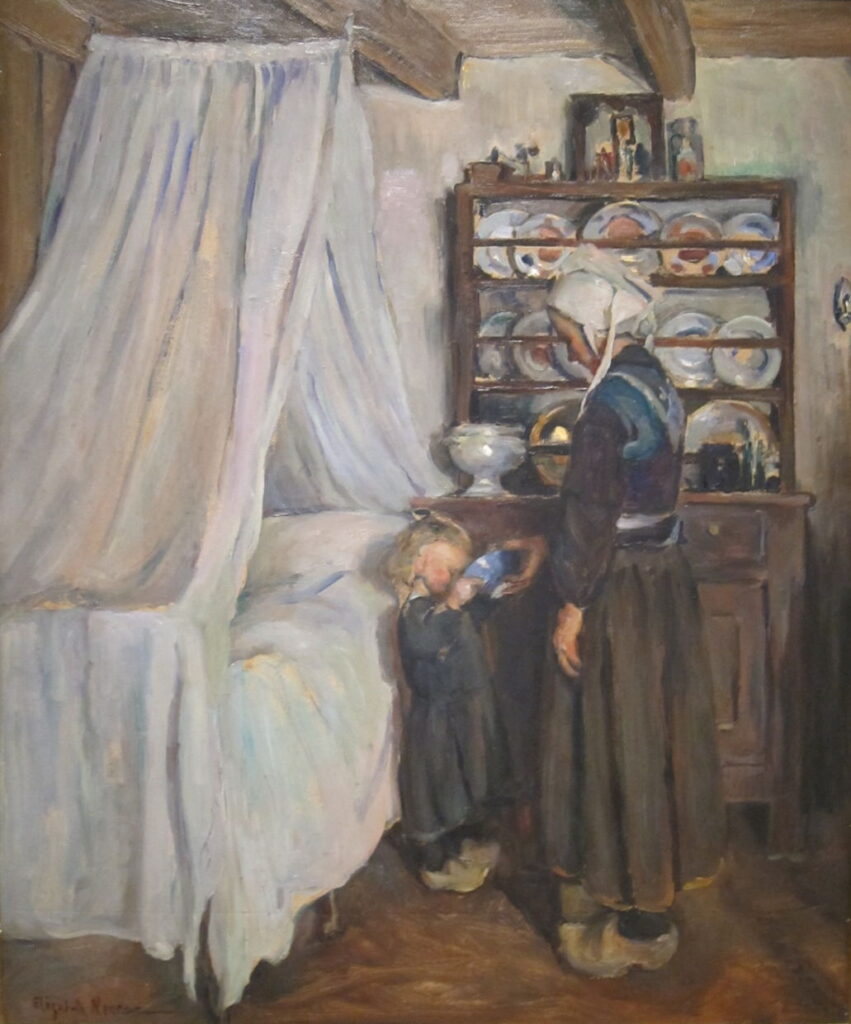Interiors by Design: Cupboards and dressers

Some of our most popular furniture is primarily intended for storage and display. This article looks at paintings of cupboards, and their specialist relatives sideboards and (Welsh) dressers. Although of ancient origins, cupboards reached a peak during the Dutch Golden Age, when the middle classes became highly acquisitive. Dressers have been traditional in some areas, including Wales, and Brittany in France, while sideboards came of age in the nineteenth century dining room.
Jean-Baptiste Greuze (1725-1805), The Laundress (1761), oil on canvas, 40.6 x 32.7 cm, The J. Paul Getty Museum, Los Angeles, CA. Wikimedia Commons.
The cupboard standing behind Jean-Baptiste Greuze’s Laundress (1761) was commonplace in many European households, and is here in the dilapidated servants’ area, probably in a cellar, where this provocative and flirtaceous young maid is washing the household linen. This was painted for Greuze’s patron, Ange-Laurent de La Live de Jully, when the artist was enjoying great success at the Salon. His reputation faded after 1780, and he lost everything in the French Revolution, dying a pauper.
Edward Burne-Jones (1833–1898), Cinderella (1863), watercolour and gouache on paper, 65.7 x 30.4 cm, Museum of Fine Arts, Boston, MA. Wikimedia Commons.
Edward Burne-Jones’ Cinderella from 1863 shows her reverted to her plain clothes after the ball, but still wearing one (the left) glass slipper. She is seen in a scullery or similar area, with a dull, patched, and grubby working dress and apron. Behind her is a densely packed display of blue crockery in the upper section of a large dresser.
Eastman Johnson (1824–1906), Not at Home (c 1873), oil on laminated paperboard, 67.1 x 56.7 cm, Brooklyn Museum, New York, NY. Wikimedia Commons.
A decade later in New York, the American genre artist Eastman Johnson painted an open narrative work that only makes any sense when you know its title of Not at Home (c 1873). This apparently shows the interior of the artist’s home, where there’s a small dresser in the parlour with a more modest display of plates and mementos.
Briton Rivière (1840-1920), Cupboard Love (1881), oil on canvas, 143 x 112 cm, The New Art Gallery Walsall, Walsall, England. Wikimedia Commons.
Briton Rivière’s Cupboard Love, from 1881, is a visual and verbal pun. The phrase refers to affection in return for gain, shown well in the two dogs whose interest lies in the food which the young woman is about to produce from the heavy wooden cupboard behind them.
William Merritt Chase (1849–1916), Studio Interior (c 1882), oil on canvas, 71.3 x 101.9 cm, Brooklyn Museum, New York, NY. Wikimedia Commons.
William Merritt Chase’s many paintings of his studio became something of a shop window for prospective customers. In his Studio Interior from about 1882, a fashionably dressed young woman is glancing through a huge bound collation of Chase’s work, sat by a grand carved wooden sideboard, decorated with almost outlandish objects including a model ship, a lute, and sundry objets d’art.
Joaquín Sorolla y Bastida (1863–1923), Kissing the Relic (1893), oil on canvas, 103.5 x 122.5 cm, Bilboko Arte Ederren Museoa / Museo de Bellas Artes de Bilbao, Bilbao, Spain. Wikimedia Commons.
Some cupboards have highly specialised roles, such as that in Joaquín Sorolla’s Kissing the Relic from 1893. At the end of Mass in the church of Saint Paul in Valencia, close to Sorolla’s childhood home, the congregation have been invited to kiss a reliquary containing an alleged relic of a revered saint, drawn from the cupboard behind the priest.
Laurits Andersen Ring (1854–1933), At Breakfast (1898), oil on canvas, 52 x 40.5 cm, Nationalmuseum, Stockholm, Sweden. Wikimedia Commons.
Laurits Andersen Ring’s wife Sigrid sits reading the newspaper Politiken At Breakfast (1898), with a modern sideboard behind her. This houses a mixture of tableware and personal mementos rather than serving as a buffet.
Carl Larsson (1853–1919), Getting Ready for a Game (1901), oil on canvas, 68 x 92 cm, Nationalmuseum, Stockholm, Sweden. Courtesy of Nationalmuseum, via Wikimedia Commons.
Further north in Sweden, Carl Larsson’s wife Karin is Getting Ready for a Game (1901) as she prepares a tray of refreshments in her dining room. At the left is a tall glass-fronted display cabinet containing glassware, while at the right is a simple sideboard with separate shelving to display decorated crockery.
Free-standing cupboards are nothing compared to those you can walk into.
Félix Vallotton (1865–1925), Woman Searching through a Cupboard (1901), oil on canvas, 78 × 40 cm, Private collection. Wikimedia Commons.
Félix Vallotton’s Woman Searching through a Cupboard (1901) uses its gloomy repoussoir to frame a woman crouching low over its contents. On the shelves above her are thick bundles of papers, such as those used in law and public administration.
Félix Vallotton (1865–1925), Interior, Woman in Blue Searching in a Cupboard (1903), oil on canvas, 81 x 46 cm, Musée d’Orsay, Paris. Image by Oakenchips, via Wikimedia Commons.
A couple of years later, in his Interior, Woman in Blue Searching in a Cupboard (1903), Vallotton painted his wife Gabrielle from behind as she stood searching in a free-standing cupboard of books.
Elizabeth Nourse (1859–1938), Breton Interior (c 1907), oil on canvas, dimensions not known, Cincinnati Art Museum, Cincinnati, OH. Image by Wmpearl, via Wikimedia Commons.
Elizabeth Nourse’s painting of a Breton Interior from about 1907 shows a well-stocked dresser beside this young girl’s bed. As dressers were unusual in bedrooms, this combination suggests the family home is very cramped, and the child has to sleep in the same room as the family eats.


